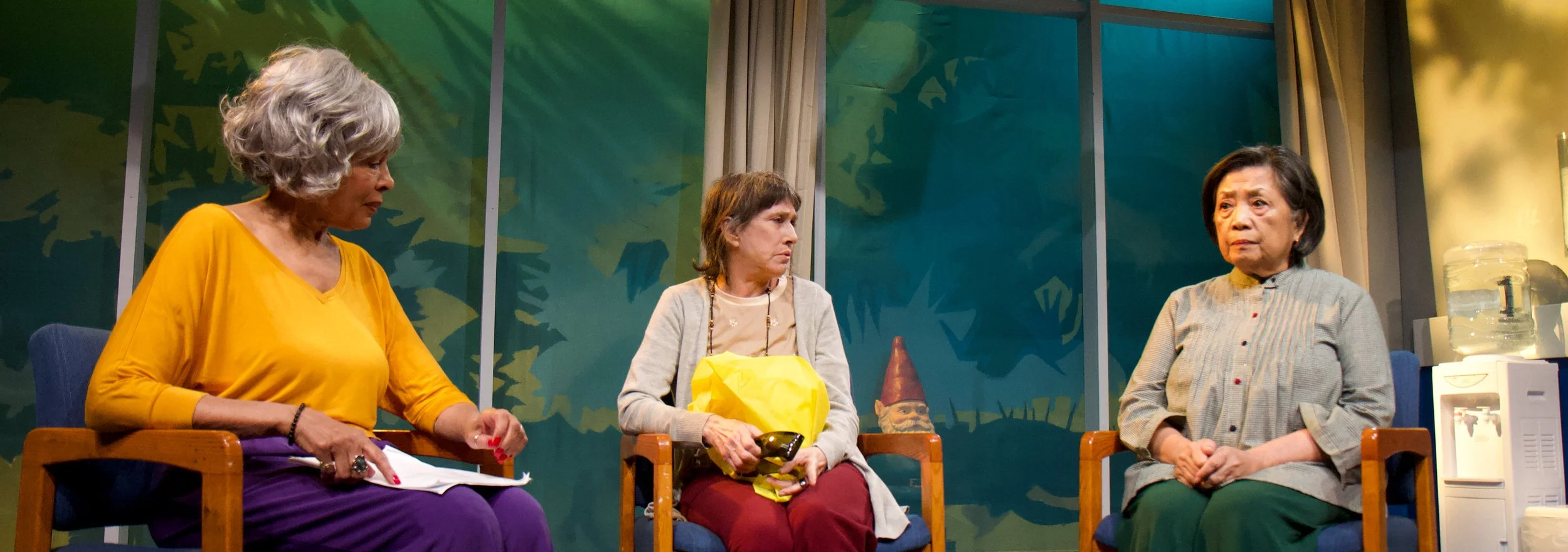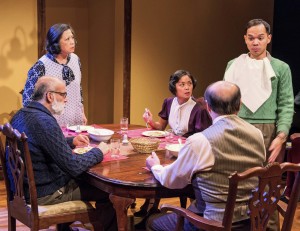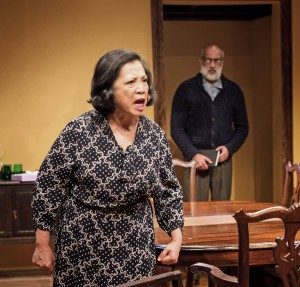Bus Stop, the third of four Broadway successes that playwright William Inge scored between 1950 and 1959 (the second, Picnic, won the 1953 Pulitzer Prize), takes place in a small-town diner on a route between Kansas City and Topeka. Grace (Cindy Cheung), the proprietor, keeps the place open all night, when necessary, as a refuge for travelers marooned by inclement weather. During a blizzard, a Topeka-bound bus arrives around 1 a.m.; the driver, Carl (David Shih), informs his four passengers that they’re stranded until highway crews clear the road ahead.
Isabel
Following its co-commission of Public Obscenities, a finalist for this year’s Pulitzer Prize in Drama, NAATCO—the National Asian American Theatre Company—leans even more heavily into the theme of gender identity with its new production Isabel, an adventurous but impenetrable 70-minute drama by Reid Tang.
A Delicate Balance
Edward Albee’s 1966 Pulitzer Prize–winning A Delicate Balance begins in the evening and ends in the morning. Hidden terrors emerge and then suddenly disappear in a drama that could be titled Long Night’s Journey into Day. As one character says, “Darkness still frightens us,” and “when the daylight comes again . . . comes order with it.” In Jack Cummings III’s slyly off-kilter production, presented in partnership with Transport Group and the National Asian American Theatre Company, the play begins in total light and ends in complete darkness. The terrors do not dissipate at dawn but linger into a new day.
Henry VI
Three productions of Henry VI, William Shakespeare’s seldom staged trilogy, have cropped up Off-Off Broadway since January. The latest, by the ambitious National Asian American Theatre Company (NAATCO), brings epic pageantry and violence to the intimate Mezzanine space at the A.R.T./New York complex on West 53rd Street.
Sagittarius Ponderosa
MJ Kaufman’s latest play, Sagittarius Ponderosa, tells the story of a young man returning home to help take care of his ailing father. The play, staged by the National Asian American Theatre Company (NAATCO), begins at a Thanksgiving dinner with the young man, his father and mother, and his grandmother expressing what each is grateful for. This opening scene is telling. On one hand, it’s a precursor to many familiar stories: a young person returning home attempting to make his way in the world, and his struggle with sexuality, love, and attachment; a child taking care of an elderly parent; a wife coming to terms with the eventual death of her husband; a grandmother’s struggle with hearing issues, and, more important, her desire to see her grandchild married. Even though Kaufman sets Sagittarius Ponderosa squarely within an Asian-American family, each of these stories is universal.
Meet the Bergers
The lives of the Berger family in Awake and Sing!, The Public Theater's production of Clifford Odets’ rousing Depression-era drama, sway to the swinging beat of old Hollywood’s silver screen. There is the drama of a young, forbidden love affair, the scandal of a child out of wedlock, the emotional carnage of lost hope and disillusionment. Rudolph Valentino receives a passing mention, and Fred Astaire croons about dancing cheek-to-cheek during intermission. Odets’ seminal play packs quite a sentimental wallop, but the National Asian American Theater Company's (NAATCO) touching revival featuring Asian-American actors in the largely Jewish-American roles, counters any mawkishness with strong, complex performances and director Stephen Brown-Fried’s confident steering.
Odets’ play centers around a Jewish family living in 1930s Bronx, and the ensuing turbulence that follows the growing restiveness of Ralph Berger (an appropriately energetic Jon Norman Schneider) and the breaking and building of Hennie Berger’s spirit (an evolution played to utter ferocity by Teresa Avia Lim). The siblings’ mother is Bessie Berger (Mia Katigbak, reprising a 2013 award-winning performance), stalwart matriarch of the family and brusque caretaker of her children’s lives. Mr. Berger (an endearingly soft-spoken Henry Yuk), on the other hand, trots about the apartment harmlessly. Rounding out the family is disillusioned academe and occasional grandfather-figure (a sage Alok Tewari) and the ever-present vitriol and violent passions of one-legged war veteran Moe Axelrod (a fantastically complex, utterly resplendent Sanjit De Silva), who has a "yen" for Hennie.
Much of the production’s conflict is courtesy of De Silva and Lim’s fiery chemistry, and Brown-Fried makes us anticipate their acerbic confrontations with glee. But aside from Ralph Berger’s erratic bursts of youthful, reckless energy (egged on by a philosophizing Jacob), the Berger kids don’t provide half as much vigor to Awake and Sing! as Katigbak’s Bessie does. Shamelessly guilt-tripping her way to what she thinks is a secure future for her children, Bessie is an unsympathetic antihero, and she dominates the power plays that rattle the household. Only Lim seriously challenges Katigbak’s governance, with Hennie’s caustic sarcasm and world-weary cynicism rivaling that of her mother’s.
Dusty browns, maroons and beiges color the set, as well as the costuming. Alexae Visel gives Bessie Berger matronly, no-nonsense dresses, while fitting Hennie with form-flattering skirts and black-buckled heels. The men get high-waist pants, oxfords and suspenders. Their fashion is reminiscent of silver screen lotharios and starlets, but Visel has imbued the clothes with hints of wear and tear. It’s occasionally difficult to catch a front view of the actors; the Public has staged the production in such a way that the performance space is sandwiched between two opposing rows of audiences. Sometimes, the effect can be quite stirring; Brown-Fried and scenic designer Anshuman Bhatia have cleverly made the space between the sofa and the dinner table into a battleground. Hennie and Moe’s emotional altercations take place in that no-man’s land, as does Ralph’s rebellious profession of love and Bessie Berger’s strict admonishments of her children.
NAATCO’s hope to carry out theater’s function in “taking people who were viewed as marginalized, and place them at the center of culture” is perhaps done so well, that we altogether forget that there is a Berger family. The characters seem to take on roles that are familiar and universal to everyone in the audience: an overbearing mother, a reckless teenage brother or a vicious old flame. Love songs from Hollywood’s Golden Age have audiences tapping their feet and humming, and the familiar twang of Bronx accents have us settling in comfortably, although hearing "goil" instead of "girl" soon trespasses on the ear. Subsequently, the supposed novelty of casting Odets’ typically Jewish-American drama with an Asian-American cast quickly dissolves; we are quite contentedly left with a fresh new realization of the Berger family. And it’s quite a sight to see.
NAATCO’s production of Awake and Sing! ran till August 8. For more information, visit www.publictheater.org.













